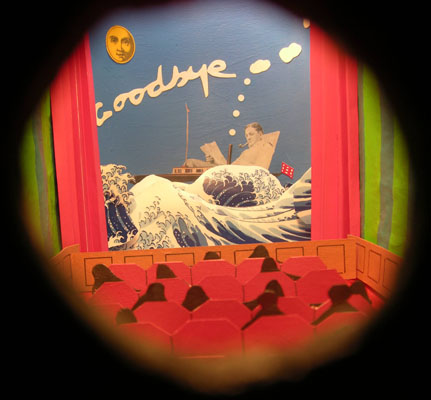CALLY TRENCH
Review of
Surprise, Surprise! (2003)
by Thea Jourdan
|
Surprise, Surprise!
Visit any gallery in the country, and you will see bored-looking children being dragged around by well-meaning adults. Brought up on a diet of computer games and interactive TV, most kids tend to think of the visual arts as dull. Like it or not, a typical ten-year-old would rather surf the net than contemplate a picture or a sculpture. Now a group of artists in High Wycombe have tackled the problem head on. Surprise, Surprise! is an exhibition of contemporary art which focuses on the surprising and unexpected. Exhibits guaranteed to keep a child's attention include a melting tea set, peephole boxes into colourful secret worlds and strange machines made of umbrella spokes, twitching feathers and bicycle brake cables. Crucially, Surprise, Surprise! is held in a familar environment - the children's schools. This is an exhibition of over 40 works so it is theerefore being held in the biggest room available - the school hall. The exhibition has toured six primary schools in Buckinghamshire and around 2000 children have had the opportunity to spend time looking at the work and thinking about it. "We have had a great reaction from the 700 pupils at this school. Even our four-year-olds have been completely delighted with the art" says Mike Ashford, head teacher of Hamilton Priamry School in High Wycombe. "The secret is the content of the exhibition which grabs your attention. Also there are always plenty of adults around to encourage and explain." In one exhibit by Kris Emmerson, a series of four full-length mirrors lines the walls. Each is inscribed with an adjective; beautiful, ugly, intelligent, stupid. The title of the piece is What you see is what you get. In another, In Space No One Can Hear You Scream, a pebble attached to a thread and an electric motor moves infinitesimally slowly up a sloping platform. This is a piece exploring the idea of perception and reality. Children gaze for hours trying to detect the slightest movement. Artist Alan Franklin asks the question, "I could tell you that it takes eight hours to pull the pebble from the bottom end to the top, but do you really know if the pebble is moving?" Art is not separate from artists. Every day of the show, two of the 15 artists visit each school in order to discuss individual exhibits with children and treachers as well as talk about their lives as artists and art that the children have made. Curator Cally Trench, who conceived the idea of the show and selected the work, is also on hand to oversee her "What is Art?" lucky dip. Children can reach in to a large bag and take a tiny scroll of paper tied with thread. Each piece of paper contains a few words, which try to answer the question, What is Art? Some of the scrolls contain maxims by famous philosophers and painters. Others contain the thoughts of local children who have already attended the exhibition and decided to contribute. Trench is adamant that the children are fully able to love and appreciate art, as long as the conditions are right. "Children are the artists, gallery owners, buyers and viewers of the future," she says. "Most younger children make art themselves in a casual and carefree way that many professional artists envy, but somehow lose interest as they get older." She believes that it is important that children do not view art exhibitions in isolation. Instead, teachers are advised to prepare classes in advance by discussing the idea of surprise. During the viewing, children are given a quiz, which requires them to look closely at the work. Each artist has also suggested activities and projects, which can be completed later. "This is a very unusual idea which we really hope we can repeat many times in the future," says Mike Ashford. "Surprise, Surprise! has really caught the children's imagination and changed the way they think about contemporary art." Thea Jourdan, 2003 Thea Jourdan writes for a variety of publications including the Daily Telegraph, The Economist and Harpers and Queen. She edited the Gallery Guide of the Scotsman newspaper for three years, which contained reviews of art exhibitions taking place throughout the UK. |
